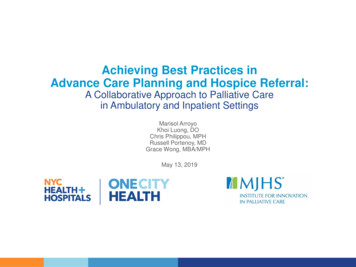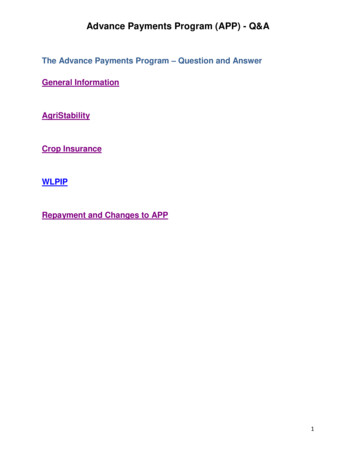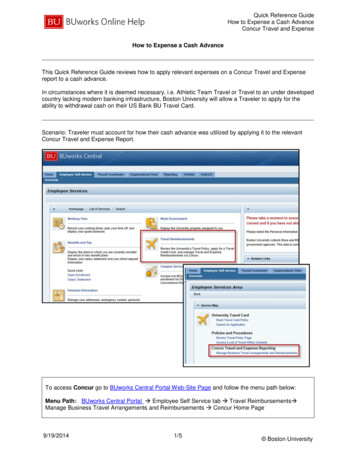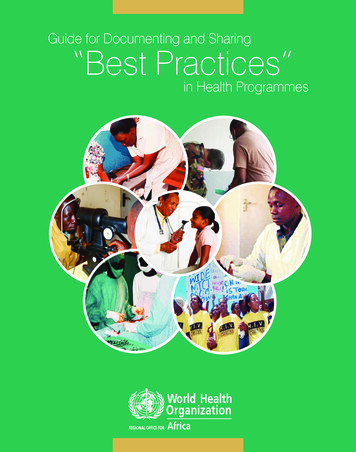
Transcription
Achieving Best Practices inAdvance Care Planning and Hospice Referral:A Collaborative Approach to Palliative Carein Ambulatory and Inpatient SettingsMarisol ArroyoKhoi Luong, DOChris Philippou, MPHRussell Portenoy, MDGrace Wong, MBA/MPHMay 13, 2019
NYC Health Hospitals today Largest public health care systemin the country Full continuum of care: 11 hospitals,6 ambulatory centers, 5 post-acute sites,70 community clinics, home-based, andNYC correctional health care in detentionand jail-based settings 1.1m New Yorkers served annually(1 in 6) with 400k uninsured Provider of nearly 1/3 of emergencydepartment encounters in NYC Nearly 1/3 of service area under 100%federal poverty level and life expectancy2.3 years less than NYC average 1 in 10 patients meet palliative careSMC definition for this intervention1
Case for palliative care, especially in aging populations The NYS population is aging at a historicrate with longer life expectancies andincreased illness burden Health care costs are concentrated ingroups of patients with severe medicalconditions (SMCs); these are the groupswho would benefit most from palliativecare intervention 25% of health care spend in last yearof life (Medicare) 30-50% of health care spendon patients with SMCs(Einav et al., 2018) Patients often enter through emergencydepartments and are admitted, thoughcould be treated in more appropriate caresettings with palliative care supportsCurrent Challenges: Capacity is limited in the community andpost-acute setting Access further constrained for uninsuredpopulations Fragmentation and lack of standardizationof palliative care services Hospice is a federal/state benefit andwhile the best benefit in health careremains underutilized in NYS NYS ranked 48th among states andPuerto Rico in hospice use byMedicare decedents Hospice use too late with median LOSof 18 days compared to 24 nationally2
Core objectives of palliative care Ensure medically-appropriate, patient- and family-centered care throughrepeated goal setting and informed shared decision making Reduce physical, psychosocial, and spiritual sources of distress or burdenand improve the quality of life for the patient and family living through seriousillness Expertly manage and navigate active dying and its aftermath
OneCity Health and MJHS partnership In June 2018, a proposal on partnershipbetween NYC H H and MJHS on“Achieving Best Practices in AdvanceCare Planning and Hospice Referral: ANovel Collaborative Practice Approach” Funded as a one-year evidencebased prototype by OneCityHealth’s Innovation Fund, thelargest PPS innovation fund NYSwide Critical to the Innovation Fund asthat we test prototypes to the mostsignificant challenges in patientswith SMCs with measurableoutcomes and innovative,sustainable solution This prototype promotes two specificobjectives tied to quality, satisfaction,and cost avoidance: Improve access to goal-settingdiscussions and advance careplanning for patients with SMCs Improving awareness and access toappropriate use of the hospicebenefit to optimize communitybased end-of-life care Upon successful intervention, statedgoal to expand this modular approachto other settings with high rates ofpatients with SMCs, including postacute sites and specialty clinics4
Prototype work plan Project timeline: 7/1/2018 – 6/30/2019 Final Report Due: 9/2/2019 Total Budget: 600,000 July 2018 – Launched at: Kings County Medical Center internal and geriatric medicine clinics Gouverneur internal medicine practices February 2019: Launched through the inpatient care transitions program at ElmhurstHospital
Target populationIn any given year, 95,000 unique patients meet MJHS’s criteria to qualify forPalliative Care Interventions* Approximately 4,100 patients are in our LTC facilitiesBased on MetroPlus claims data: Top 4% patients meeting criteria incurred 2,432 PMPM Top 1% patients meeting criteria incurred 4,035 PMPM As compared to costs of all other patients, 236 PMPM* See Appendix for eligibility criteria6
Prototype overview Trained palliative care clinical liaison embedded in a practice and linked to palliativecare experts with the needed high-level clinical competency Proactive identification of patients with SMCs at-risk for avoidable utilization The patient and family journey: Starts with initial outreach to and conversation with patient and/or family Includes iterative discussions, hospice eligibility review, and communication with thepatient‘s physician and care team Encounter is documented and an advance directive is filed If the patient is hospice -eligible and -appropriate, assistance is offered Time-limited intervention offered until:o Goals are clarified and documented in the EMRo Advance directive is up-to-date and in the EMR, and/oro Hospice eligibility and appropriateness confirmed with patient and family
Evaluation and results to date Three in four patients have new or updated advanced directives Nearly one in five eligible patients discussed hospice care with the care team, resultingin enrollments based on patient and family preferences Final evaluation to determine impact on quality and cost of careDurationEligible PatientsAverage Age%WomenAmbulatory Practice 1Ambulatory Practice 2Inpatient ProgramStart-up 8 mosStart-up 7.5 mosStart-up 2 mos4151941676.0 years, SD: 11.477.6 years, SD: 11.075.2 years; SD: 12.662.2%61.9%44823617Updated/New AdvanceDirectives294949Hospice options discussed59211Hospice enrollments17100Total Discussions56.3%
Lessons learned Dedicated administrativeresources to foster partnershipand ensure that the practice hasbuy in at sites to implement aprototype that meets ourdefined aims, objectives, andstandards in care Effectiveness depends on theClinical Liaison’s timeavailability (i.e. resources),cultural competence, and highlevel palliative care clinicalcompetency Requires a strong partnershiptrusted by front-line staff andadministration, integration ofnew workflows into existingprocesses, and continualcollaboration to identify patients Focusing resources to sites andpractices with higher prevalenceof patients with SMCs, such aspost-acute care settings andadvanced specialty clinics, willonly enhance programeffectiveness
What’s next?Scaling to aging patients with SMCs residing in postacute settings Post-acute service line has implemented and standardized use of advanceddirectives and Medical Orders for Life-Sustaining Treatment (MOLST),though an existing unmet need in palliative care supports Focus on selected nursing homes and the main hospital(s) that refer to them(the nursing home-hospital “dyad”) Embedded clinician identifies patients at both the hospital (awaiting transfer)and nursing home Eligible patients receive the intervention Documentation and distribution of advance directives go to both hospitalEMR and nursing home EMR* See Appendix for information on post-acute service line
OneCity Health–MJHS modular, scalable solution Clinical dyad embedded in NYC H H care team: Clinical liaison Palliative care-trained physician Project management and governance Data/analytics and evaluation support Annual budget: Existing model: 300k / site / year To scale model to all sites and reach highest need for palliative careservices (7,000 patients with SMCs at 11 hospitals and 5 post-acutelocations) – 4.8M / year11
To discuss the prototype and partnership opportunities:Grace Wong, MBA, MPHCOO and Chief Network Officer, OneCity Health Phone: (646) 694-7142 Email: wongg3@nychhc.orgChris Philippou, MPHDevelopment Officer, OneCity Health Phone: (646) 694-7128 Email: philippc1@nychhc.org12
Appendix
MJHS palliative care intervention criteriaCharacteristic 1: ComorbiditiesConditionICD10 CodeQOF ratingAtrial FibrillationI481CancerC00-C96, excludes C443COPDJ41-J442DementiaG30, G31, F00, F01-F033DiabetesE10-E141Epilespy (treated)G40, excludes G40.4, G412Heart FailureI11.0, I13.0, I13.2, I502Psychosis, Schizophrenia, BipolarF20, F22-F25, F28-F31, F32.3, F33.32Stroke or TIAG45, I61-I641Chronic kidney diseaseN18.3, N18.4, N18.52Chronic liver diseaseK70.3, K74, K74.5, K74.62Positive ScoreSum of ratings 3Characteristic 2: ADL Performance or DeclineADLs RatedScoreBathing, Personal Hygiene, Dressing, Upper Body, Dressing, Lower Body, Walking, Locomotion, Transfer Toilet,Toilet Use, Bed Mobility, EatingRating 0-6 for each ADLChange in ADL status as compared to 90 days ago, or since last assessment if less than 90 days agoImproved, Declined, no change,uncertainPositive ScoreScore 3 for any ADL, OR"decline" for second itemCharacteristic 3: Hospitalizations or ED visitsUtilizationInpatient Acute Hospital with Overnight StayER VisitScorePositive Score# of times in past 3 months 1 IP or ED visit14
Post-Acute Care (PAC) Service Line OverviewComprised of five skilled nursing facilities, a longterm acute care hospital and three adult dayhealthcare programs. There are a total of 2,099inpatient beds in the SNFs and LTACH and 29,982visits per year in the ADHCs.Accomplishments: Implemented and standardized use of advanceddirectives and Medical Orders for Life-SustainingTreatment (MOLST) Earned four & five Star Ratings awarded byCMS and Carter LTACH is Joint Commissionaccredited. Gouverneur and Seaview have been recognizedby US News & World Report as one of the BestNursing Homes in NY 2018/2019Provider NameOverallRatingHENRY J CARTER SKILLEDNURSING FACILITY5COLER REHABILITATIONAND NURSING CARE5NEW GOUVERNEURHOSPITAL S N F5SEA VIEW HOSPITALREHABILITATION CENTER5DR SUSAN SMITH MCKINNEY4
MOLST Implementation in the PACIn 2018, the Post-Acute Service Line standardized the Advanced DirectivePolicy and Procedure and implemented the MOLST Multi-disciplinary workgroup reviewed all facility-specific Advanced Directives P&Psand all Advanced Directives data Developed and implemented a standard education curriculum including PalliativeCare education for all staff Educated residents/patients/families on MOLST and Palliative Care Developed standard metrics to measure effectiveness of the MOLST strategiesimplemented Identified MOLST Champions at each PAC site to assist with project roll-outSince standardization and implementation, the Post-Acute Service Line hasincreased MOLST from 59% in Q1 2018 to 88% in Q1 2019.
Achieving Best Practices in Advance Care Planning and Hospice Referral: A Collaborative Approach to Palliative Care in Ambulatory and Inpatient Settings Marisol Arroyo Khoi Luong, DO Chris Philippou, MPH Russell Portenoy, MD Grace Wong, MBA/MPH May 13, 2019. NYC Health Hospitals today Largest public health care system in the country Full continuum of care: 11 hospitals, 6 ambulatory centers .










